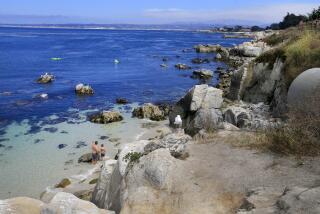A Dual Challenge: Conserve Resources and Protect Access
- Share via
The Channel Islands National Marine Sanctuary is engaged in a fascinating decision making process regarding the establishment of marine reserves.
The sanctuary consists of 1,200 square miles surrounding Santa Barbara, Anacapa, Santa Cruz, Santa Rosa and San Miguel Islands. As one of 13 national marine sanctuaries, Channel Islands is mandated to protect “significant cultural (and) natural resources” within its boundaries while simultaneously protecting access and resource extraction.
The sanctuary is an area of multiple uses, and the harvesting of kelp, fish and invertebrates is permitted in most areas. Prohibited activities include disturbing marine mammals and birds, flying motorized aircraft at less than 1,000 feet over the water within one nautical mile of any island, and removing or damaging any historical or cultural resource. Further prohibitions include the discharge of substances into sanctuary waters except fish or bait, cooling water and biodegradable effluents incidental to vessel use, effluents incidental to hydrocarbon exploration and extraction as defined by law, and alteration of, or construction on, the seabed except in connection with the laying of any pipeline.
The question of marine reserves, or no-take zones, introduces a new and rigorous management tool in response to declining fisheries and increasing threats to ecosystem biodiversity. There is an international consensus among marine scientists that a network of marine reserves presents the most powerful tool for enhancing biodiversity and mitigating damage to marine ecosystems. On the other hand, there is significant concern among both commercial and recreational users that reserves will severely limit access to the most productive areas of the sanctuary. Agency staff must balance its mandates and constituencies.
As a federal agency, Channel Islands sanctuary is required to solicit public input into any regulatory decision it makes. The marine reserve process, however, goes well beyond any required public participation. In fact, the sanctuary may be ahead of all other federal agencies in giving the public a seat at the table.
*
The challenge is significant. On one hand, Channel Islands sanctuary has to balance competing mandates established in the National Marine Sanctuary Act: conservation of marine resources and protection of public and commercial access to the sanctuary. On the other, the agency takes its partnership with the public seriously. Yet, marine reserves seriously impact users of sanctuary resources.
To meet this challenge, Channel Islands sanctuary has convened a stakeholder working group and a science advisory panel to better link science and policy preferences from the start.
Those aspects of the science panel’s assessment that were based on normative judgments--such as defining goals and objectives--were given to the working group. Those aspects of the working group’s discussion that relied upon science-based information were reviewed by the science panel. In addition, a socioeconomic panel collected economic data, including a survey of commercial fisherman in the affected areas, and made those data available to the working group.
The process represents the best ideal of civic science, where stakeholders are integrated into the scientific process of evaluation.
Many observers have noted that the assumptions of science and policy are fundamentally different. Science is empirical: It assumes a high degree of training and expertise, there is a narrow protocol of acceptable methodologies and outcomes are empirically justifiable according to these methodologies. By definition access is limited. In contrast, policy is normative: defining what we ought to do. Policy assumes multiple interests and stakeholders. There is no agreed-upon protocol; multiple methodologies are used. Policy outcomes are not empirically justifiable. And policy access is--at best--unlimited.
Stated another way, if science is rational and democracy is nonrational, there is bound to be conflict. It is no surprise, then, that bringing effective science into the policy process has been extremely challenging. Integrating science into effective resource management has been a challenge to federal agencies for many years.
*
The National Oceanic and Atmospheric Administration’s marine sanctuaries have developed an innovative approach that may provide a model across the nation. Channel Islands National Marine Sanctuary is at the forefront of this trend.
Although its process is not yet complete, it is clear that this evolving model is closer to resolving the paradigmatic conflicts that have long kept science and participatory policymaking at arm’s length. When scientists and interest-based stakeholders are successful at linking their analytic approaches, a truly civic-science based rule making process will have emerged.
More to Read
Sign up for Essential California
The most important California stories and recommendations in your inbox every morning.
You may occasionally receive promotional content from the Los Angeles Times.













